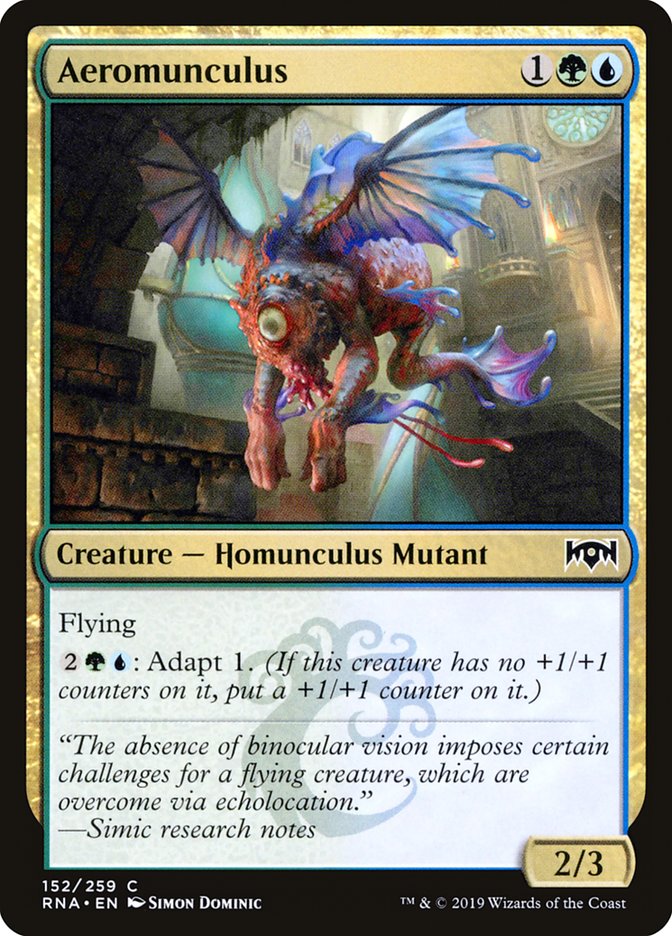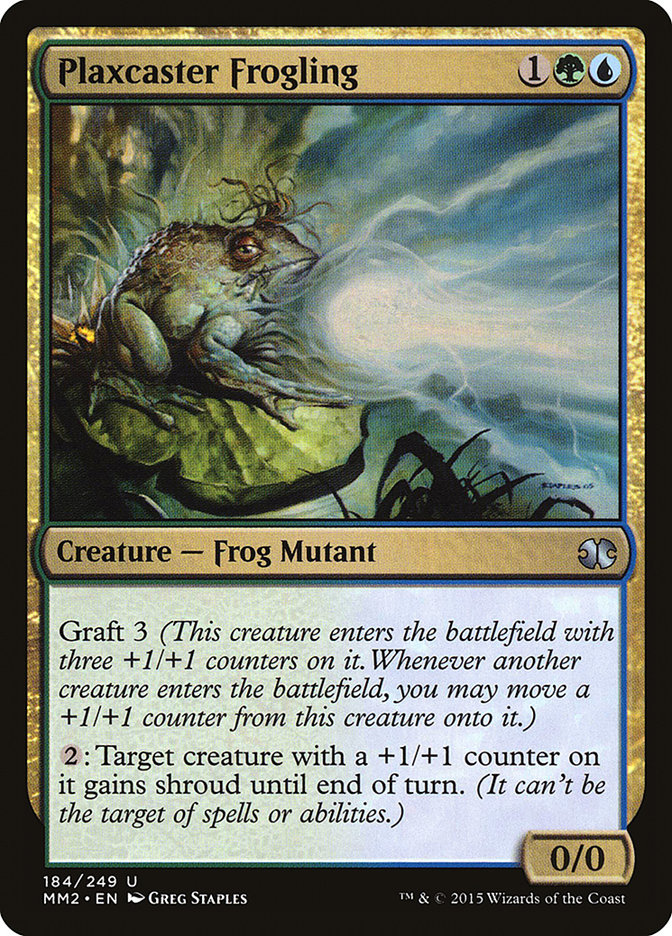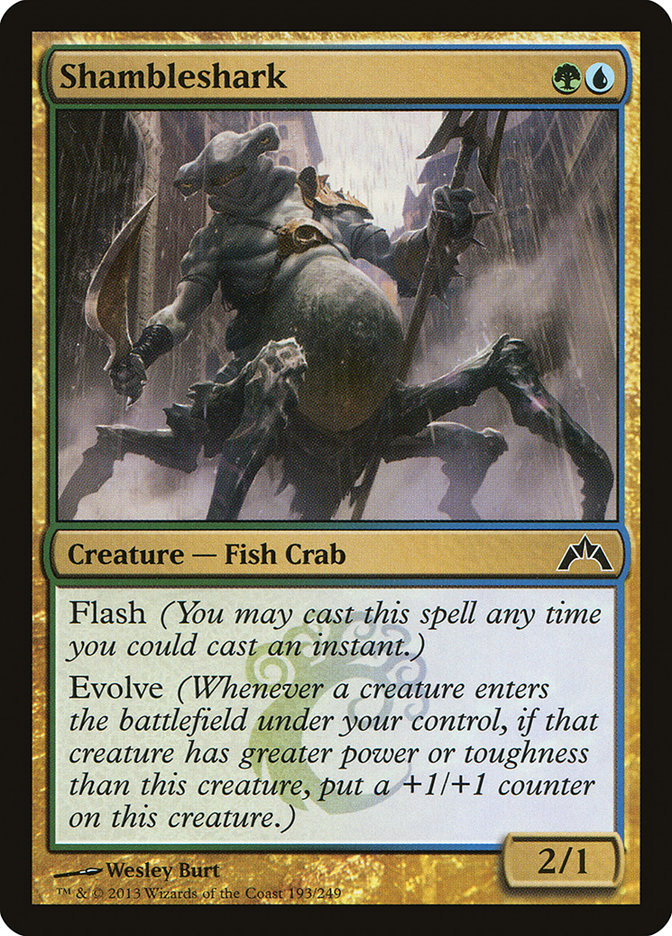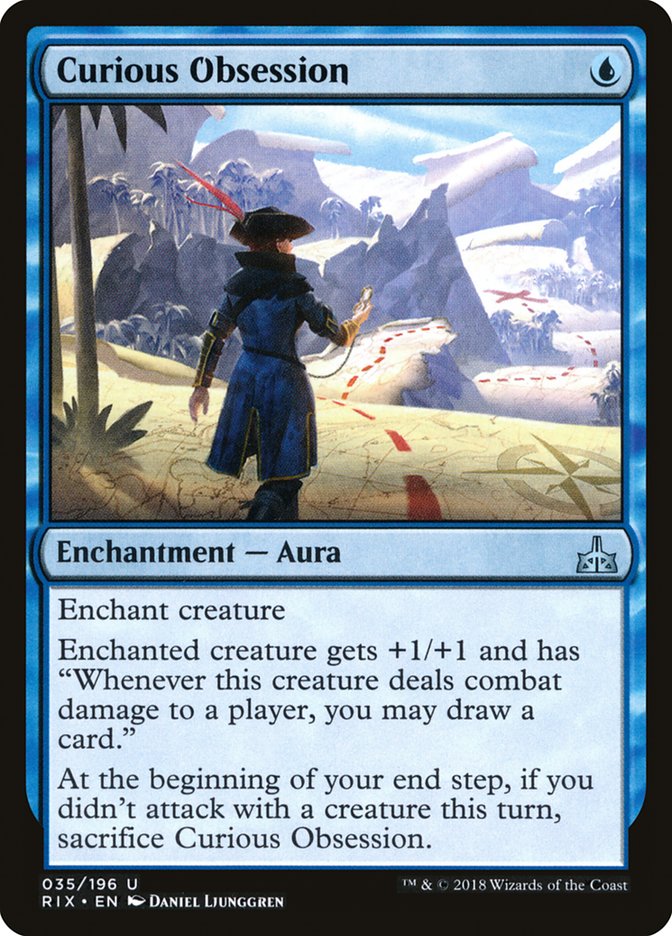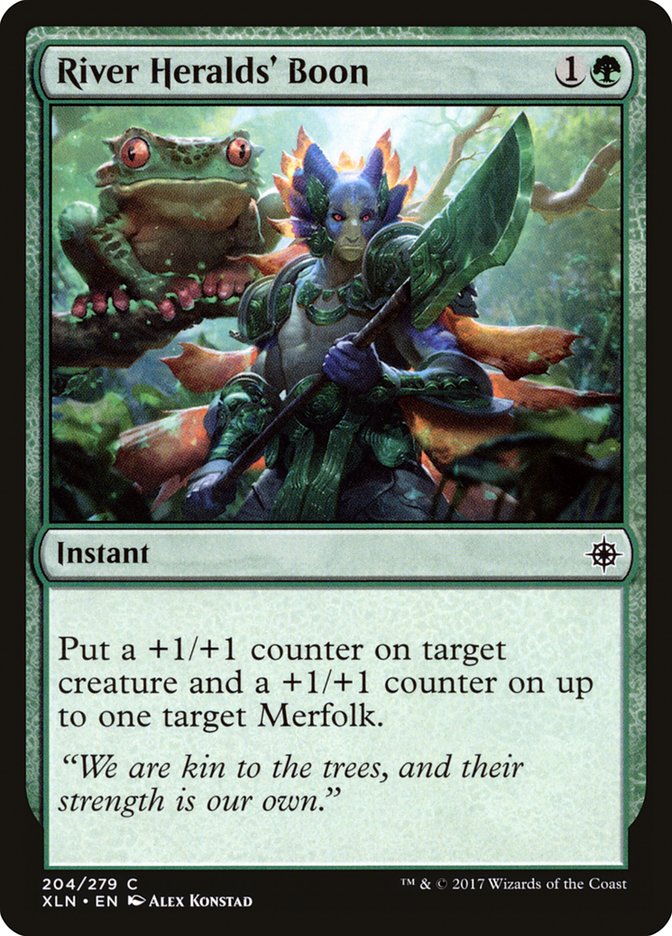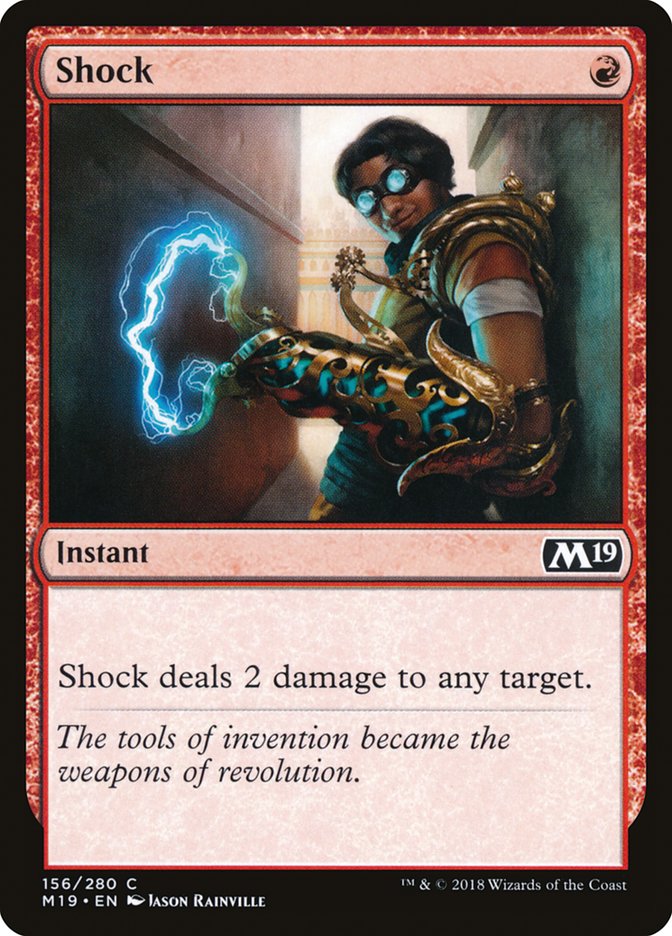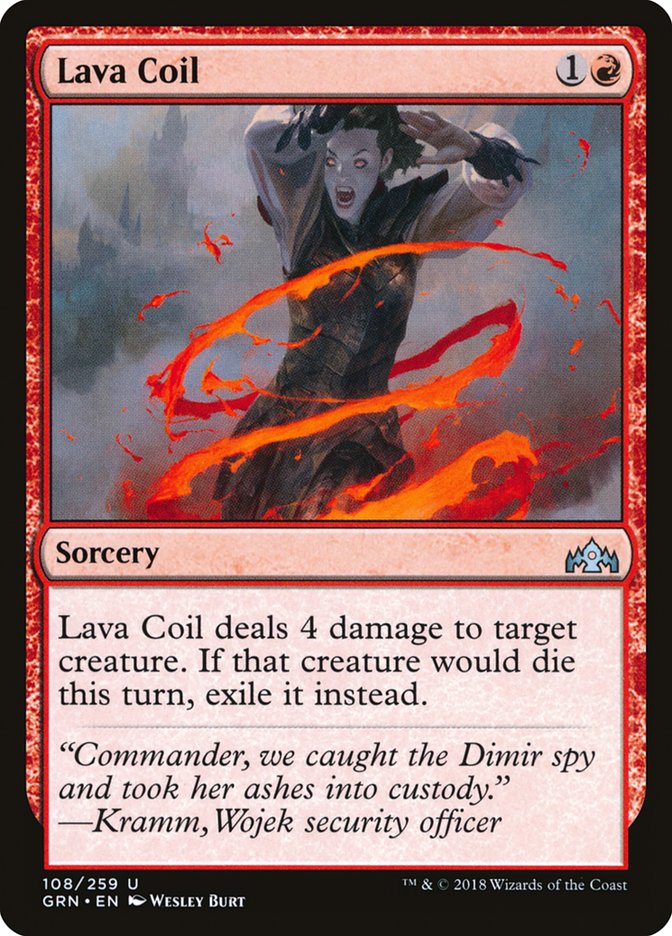We’ve now learned the Simic mechanic, adapt:
If you’re trying to figure out how it’s different than monstrous, I don’t
blame you, but the answer is that it’s slightly easier to track and
theoretically synergizes with things that move or remove counters. Not the
most novel mechanic – it’s honestly in the running for most derivative –
but as always, it’s really just going to be a question of how it plays.
Consider afterlife, whose presence in the set tells us we should expect
that games of Limited will often involve some random 1/1 fliers left over
in the midgame, so 2/1 flying creatures are probably a lot worse than they
would be in other sets, while 1/2 Spiders would be a little better. How
interesting this mechanic is is a function of what other cards let us do
interesting things with these 1/1 tokens.
Compare this to something like jump-start, another relatively uninspired
mechanic, but it is one that told us that instant and sorcery spells would
be cast a little more often than in other Limited formats, so the set was
able to include a lot of triggered abilities that trigger when spells are
cast. This set should have cards that interact with small creatures in some
way, to make afterlife interesting, and it should also have cards that care
about +1/+1 counters specifically, much the way Zegana, Utopian Speaker
itself does. I expect this to be very common among Simic cards in general,
and cards with adapt specifically.
Considering how Simic has played before, I’m expecting this to play like a
simplified combination of its previous incarnations. With graft, creatures
shared abilities between each other because they had abilities that let
them give their keywords to other creatures with counters (which they could
also give them). With evolve, creatures got bigger over the course of the
game. Here, I’m expecting that creatures will start out relatively vanilla,
but they’ll be able to put counters on themselves to grow (only once), and
when they do, they’ll pick up abilities that other creatures are offering
using the same templating as Zegana’s last ability. I’d probably bet at
even money that there will be a card in this set that says, “Each creature
you control with a +1/+1 counter on it has flying.”
So, I expect the play pattern of adapt and Simic to be very different than
the play pattern of monstrous. Monstrous provided a mana sink to offer
decks a big effect in the late game, and each monster very much stood on
its own. With Simic, I expect the way that creatures share abilities and
look for other creatures with counters to mean that you’re encouraged to
draft many adapt creatures so they can work together, which means you’ll
need to plan to have time to activate each of them. This will get mana
intensive, so you’ll be looking to play a more defensive/longer game. This
is to say that while the mechanics of adapt may be totally generic, I
expect the other words on the cards to do the heavy lifting in capturing
the expected feel of “Simic gameplay.”
Now, ultimately, a mechanic this mana intensive isn’t what anyone’s looking
for in Constructed, so we’ll need a card that’s pushed to Fleecemane Lion
levels for it to break through; in other words, we’re mostly looking for a
card that’s roughly good enough without adapt, or that has a very cheap
adapt cost.
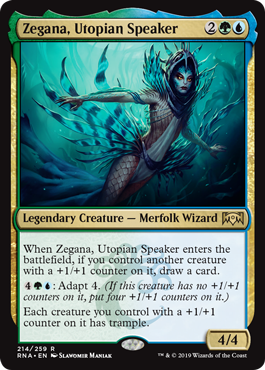
Zegana, Utopian Speaker is a four mana 4/4 that draws a card when it enters
the battlefield under the right conditions, so it’s like a Crackling Drake
that’s easier to cast, but harder to trigger, but ideally both decks should
be constructed such that when you have four mana, you can usually cast the
appropriate card and draw a card. That’s a bigger deckbuilding restriction
for Zegana, but Crackling Drake has an additional deckbuilding restriction
that you need to have Instants and Sorceries in your graveyard or exiled
for it to have power. Crackling Drake is the better standalone body, but
Zegana will have better tribal synergies. Really though, if Zegana is going
to be good, it’s going to be a function of the last ability. Giving all
your creatures trample can matter a lot when they all have +1/+1 counters,
and that’s what Zegana’s going to be about.
This means Zegana isn’t a card you’re going to want to play more than
around two-of. It’s expensive for a Merfolk deck, it’s legendary, and
you’re really hoping that it just lets you kill someone with the other
creatures you have on the battlefield as soon as it comes down.
It’s definitely the case that Zegana doesn’t have to play with other
Merfolk. If there ends up being a deck built around creatures with +1/+1
counters regardless of type, Zegana would work perfectly well there, but as
it happens, Merfolk were already dealing pretty heavily in +1/+1 counters,
so Zegana fits right in. Ravnica isn’t a tribal block and historically,
there have been very few Merfolk, so I’d be surprised if we get more than
one more Merfolk in Ravnica Allegiance (and my expectation is
zero), but we will get the most important Merfolk card: Breeding Pool.
So what might Merfolk look like in the next Standard format?
Creatures (32)
- 4 Silvergill Adept
- 4 Kumena's Speaker
- 2 Merfolk Branchwalker
- 3 Vineshaper Mystic
- 4 Kumena, Tyrant of Orazca
- 4 Merfolk Mistbinder
- 4 Deeproot Elite
- 2 Jade Bearer
- 4 Mist-Cloaked Herald
- 1 Zegana, Utopian Speaker
Lands (22)
Spells (6)
Sideboard

There are a few different directions you can go with Merfolk. Here, I’m
trying to take advantage of the synergy between Deeproot Elite and Deeproot
Waters, which makes each of your Merfolk trigger Deeproot Elite an extra
time, and offers hexproof creatures for Deeproot Elite to put counters on.
Dive Down protects Deeproot Elite and Kumena, Tyrant of Orazca, which are
far more important than your other creatures.
In sideboarding, against control decks the plan is to add counterspells and
Curious Obsession and switch from going wide (cutting Deeproot Elite) to
just protecting a creature with Curious Obsession the way Mono-Blue Aggro
does now.
Against opposing creature decks, instead of playing creature removal, my
idea is to just bring in River Heralds’ Boon to punish people for trying to
block while keeping my focus on being proactive and getting bigger
creatures than my opponent.
So how might this deck line up in Standard moving forward?
The biggest concern is that it needs a bit of time to get going. Taking the
third turn off to play Deeproot Waters is scary, even if it lets you
potentially catch up quickly, and there are a lot of creatures that start
with only one toughness. If your opponent has cheap removal to keep up with
your creatures, creatures that rely on other creatures being on the
battlefield (which include all of your three- and four-mana creatures)
become a lot worse. This means that if Izzet Drakes with four copies of
both Shock and Lava Coil remains popular, they can probably answer your
early creatures and then take over with fliers before you can rebuild.
On the other hand, if people play decks like Golgari and rely on creature
combat and four-mana removal spells, you should fairly easily be able to
make your creatures larger than theirs and you won’t depend on any single
creature by the time they can start killing them, so you just have to be
careful to make creatures that survive Finality and the matchup should be
very good.
Similarly, you’d probably do well against Boros Aggro simply by out
matching their creatures.
Against decks with real sweepers, you’ll really be leaning on your
sideboard plan.
Mono-Red Aggro will be difficult. You don’t have good answers to
Runaway-Steam Kin, they have cheap removal for your lords, and
Goblin-Chainwhirler should be able to kill a creature or two when it enters
the battlefield.
In short, Merfolk looks to be a deck that can succeed or fail depending on
the metagame, and one that would rather play against midrange decks or
control decks if the sideboard works well. If it has to play against an
aggro deck, it wants to play against an aggro deck with minimal
interaction. In general, the less red removal the opponent has, the better.
Merfolk could also make some concessions to improve the Mono-Red matchup,
replacing Vineshaper Mystic with Swift Warden, for example, would likely be
a pretty big improvement. Another option would be to rebuild the deck to
support Wildgrowth Walker:
Creatures (30)
- 4 Silvergill Adept
- 4 Kumena's Speaker
- 4 Wildgrowth Walker
- 4 Merfolk Branchwalker
- 4 Kumena, Tyrant of Orazca
- 4 Jadelight Ranger
- 4 Deeproot Elite
- 2 Zegana, Utopian Speaker
Lands (22)
Spells (8)
Sideboard

The Carnage Tyrant in the sideboard is really a placeholder, as I’m
expecting some powerful Simic Mythic that this deck would probably want in
the sideboard.
This deck is a lot less vulnerable to red removal because it has more value
creatures and Wildgrowth Walker is just always great against red. This
build keeps a lot of the strength of the other build while shoring up
weaknesses. It’s a little less synergistic because it loses Merfolk
Mistbinder, but this might just be an example of how it’s important not to
get attached to certain cards and to look at how they make the deck line up
in the format. The first build felt like the way these cards want to go
together, but this build is likely a better approach to building the deck,
having thought through how it would actually line up.
This is an example of a larger point in this format about how many ways
there are to build each deck, how all your choices really matter, and how
it’s worth spending time identifying your weaknesses and figuring out how
you can mitigate them because this Standard format is deep enough that
there’s usually a way.


